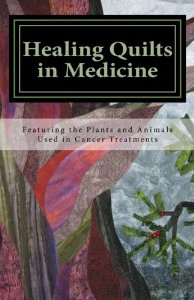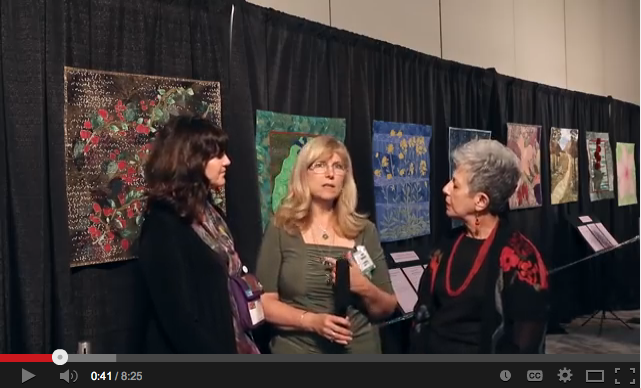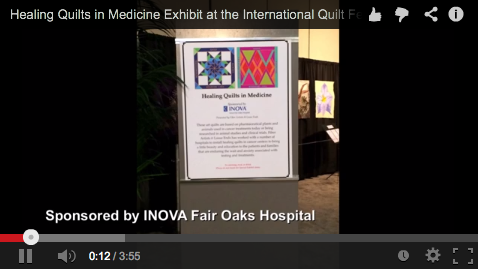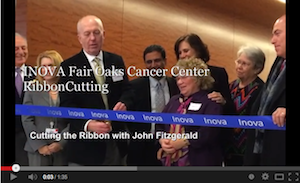 |
Christine L. Adams
Beneficial Blue: True Indigo (Indigofera tinctoria)
Indigo is thought of as a vibrant natural blue dye but it has other life enhancing properties as well. It is often used in field rotation; it was a favorite medicine of the indigenous people of N. America who applied it to burns, cuts, and scrapes; and, it is found in modern drugs to stimulate the immune system.
A chemical compound isolated from indigo, indirubin, has shown to be effective for treatment of chronic myelogenous leukemia.
Survivor Tribute: Jill Schumann, Breast Cancer, 1989 |
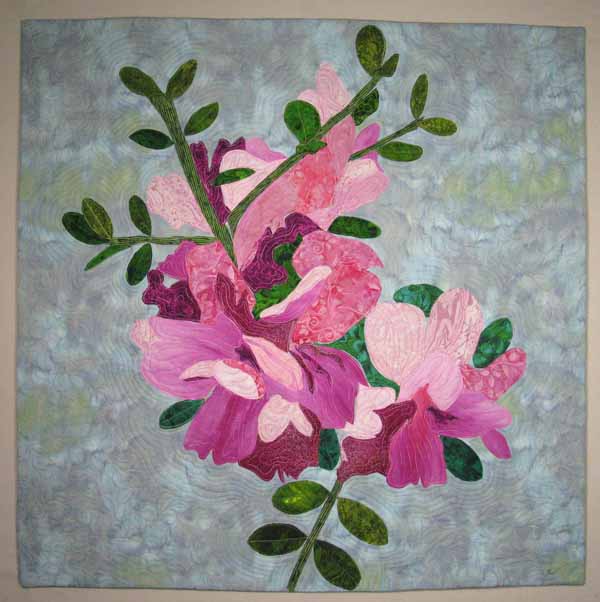 |
Bunnie Jordan
True Indigo (Indigofera tinctoria)
Indigofera tinctoria is active against chronic myelogenous and other leukemias as well as some lung cancers. The aerial parts of the plant are being researched for antihepatoxic properties. I chose to focus on the blossom part of the plant as blossoms have long been thought to symbolize the promise of life.
Survivor Tribute: Brad Jordan, Stage IV Hodgkins Lymphoma, 1998 (age 16) |
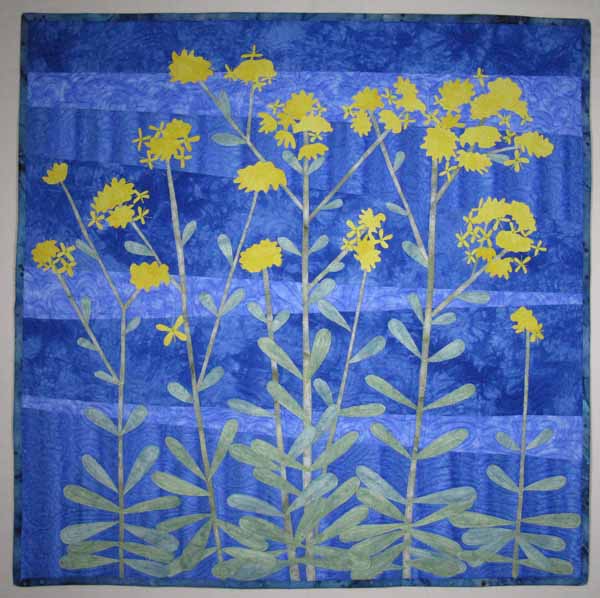 |
Vivian Milholen
Dyer's Woad (Isatis tinctoria)
Indirubin, a compound found in the Isatis root, has been shown to be effective in treating myelogenous and other leukemias as well as some lung cancers.
Survivor Tribute: Della Milholen (Mother-in-Law), Skin Cancer 2001 |
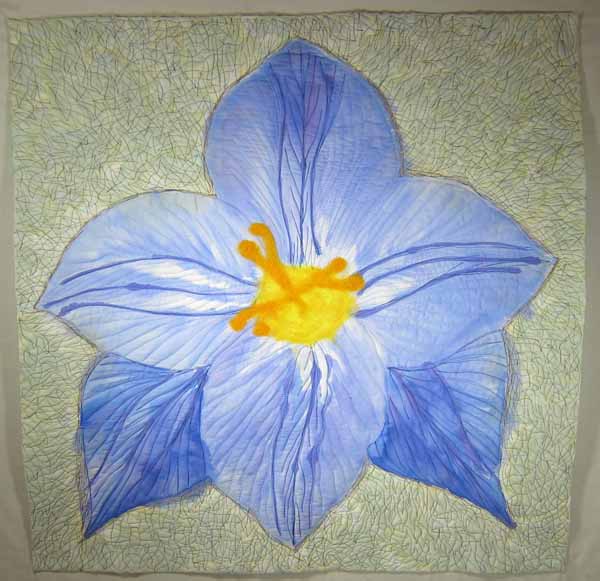 |
Sandi Goldman
Autumn Crocus (Colchicum autumnale)
I hope this beautiful flower is the cure we all hope and pray for.
The crocus produces a toxic chemical compound called colchicine, which is showing promise in treating a range of leukemic and solid tumors cancers.
Survivor Tribute: Karen Osterloh, Breast Cancer, 2011 |
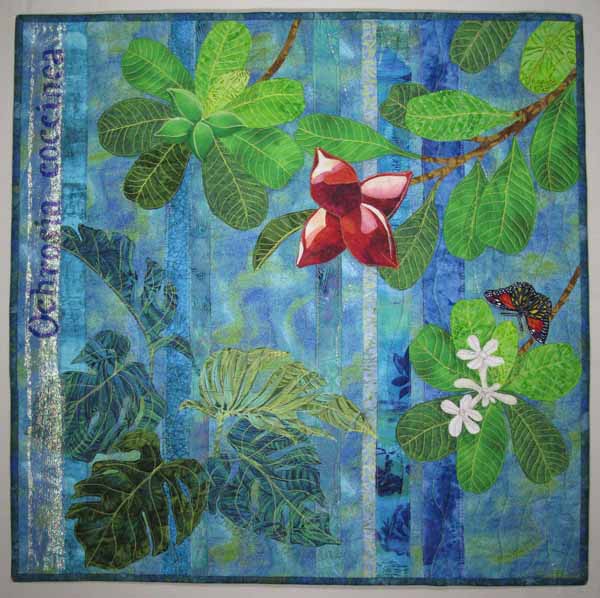 |
Carole A. Nicholas
Up Into the Forest Canopy (Ochrosia coccinea)
The tropical plant Ochrosia coccinea provides the chemical Ellipticine. This compound shows promising anti-tumor properties against breast, thyroid and ovarian cancers.
Survivor Tribute: Sue Langley, Breast Cancer, 2006 |
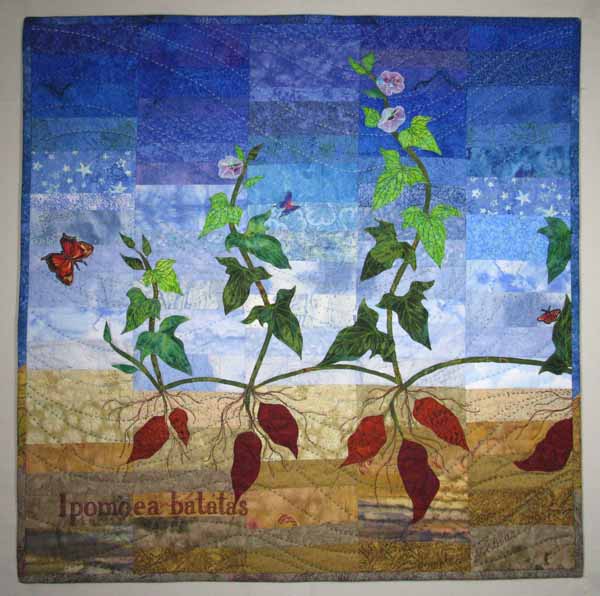 |
Carole A. Nicholas
One Potato, Two Potato (Ipomoea batatas)
The Sweet Potato plant, Ipomoea batatas, produces 4-Ipomeanol when attacked by the fungus Fusarium solani. It shows promise in treating lung cancer.
Survivor Tribute: Liza Chang, Breast Cancer, 2000 |
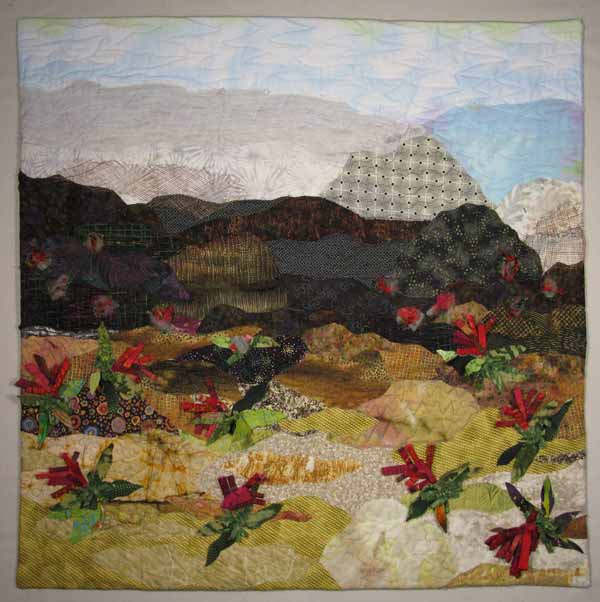 |
Annabel Ebersole
Firecracker Bush (Bouvardia ternifolia)
I was fascinated by the name of this plant and the challenge of making it look like a cluster of small trumpets bursting from the stem. Creating a sandy and rocky background for this sturdy plant shows how we humans can likewise thrive when we go through our rocky times.
Bouvardia ternifolia produces the chemical compound bouvardin that has been studied for anticancer properties.
Survivor Tribute: Catherine Griffin, Multiple Myeloma, 2008 |
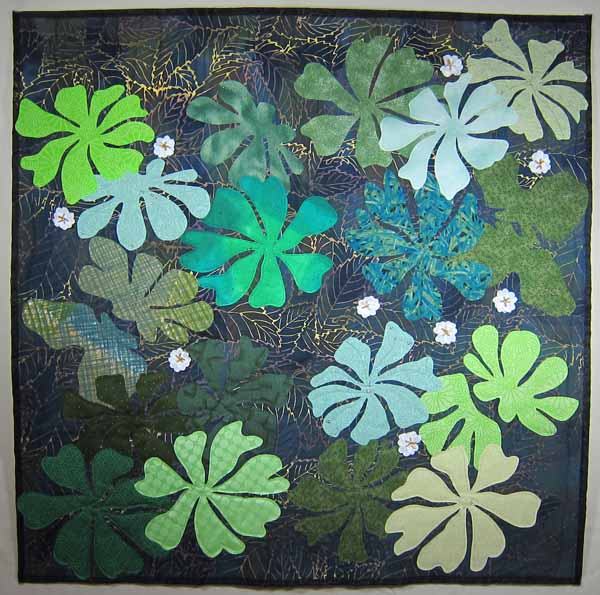 |
Judith Busby
Mayapple (Podophyllum pelatum)
Our forest floor was covered with mayapple plants with their big, umbrella shaped leaves. We appreciated the beauty of the plant; but never realized the importance of its medical uses.
Podophyllum peltatum provides etoposide and teniposide, which are used against small-cell lung, testicular cancer as well as lymphomas and leukemia.
Survivor Tribute: Kathy Jones, Breast Cancer, 2008 |
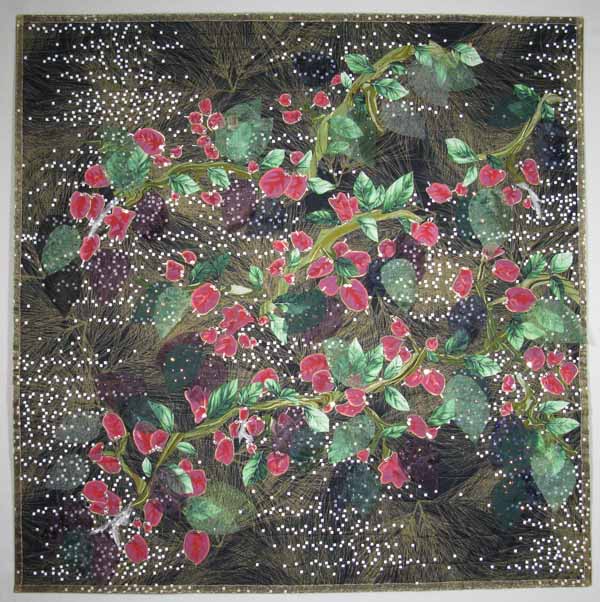 |
Judith Busby
Thunder God Vine (Tripterygium wilfordii)
The vibrant red of the Tripteyrgium wilfordii vine is a beautiful plant that is the source of active compounds used to treat cancer.
Triptolide is derived from Tripteyrgium wilfordii. It is showing promise for colon, squamous cell and pancreatic cancers as well as lymphomas and leukemias.
Survivor Tribute: Kathy Jones, Breast Cancer, 2008 |
 |
Paula Golden
Purple Meadow Rue (Thalictrum dasycarpu)
Thalictrum dasycarpum contains the chemical thaliblastine and shows promising effects on ovarian cancer cells and other resistance in human malignancies, including leukemia.
Survivor Tribute: Thelma Barr, Breast Cancer, 1980 |
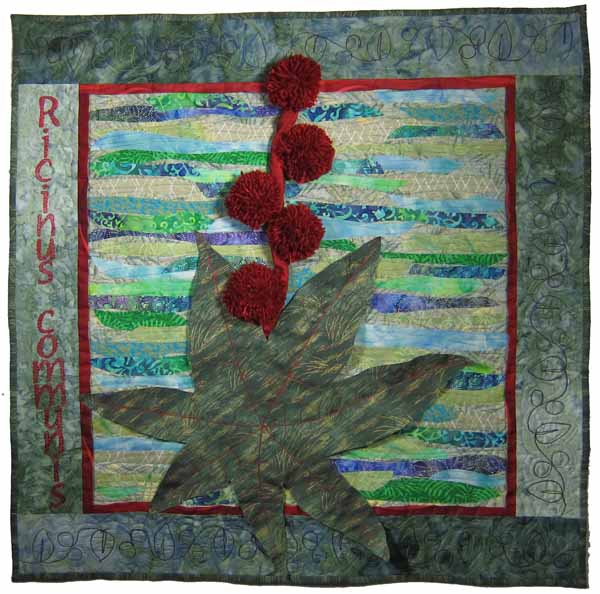 |
Lisa Ellis
Castor Bean (Ricinus communis)
I chose the Castor Bean because of its promise in melanoma treatment. My husband is a twenty-two year survivor.
Ricinus communis is a source of ricin. Ricin is used against metastatic melanoma, metastatic colon cancer, and other cancers.
Survivor Tribute: Michael Ellis, Melanoma, 1991 |
 |
Barbara Hollinger
Pacific Yew (Taxus brevifolia)
Native Americans have long used Pacific Yew for its healing powers. The Pacific Yew (T. brevifolia), yields the complex compound found in Taxol. Used in treating breast and ovarian cancer, this chemical is found in the bark, leaves and heartwood of this slow growing trees but it requires nearly 63 pounds of bark to treat one patient. Rigorous research has not only isolated the compound, but also developed a way to synthesize the chemical saving both trees and patients alike.
Survivor Tribute: Kim Wertz, Breast Cancer, 2008
|
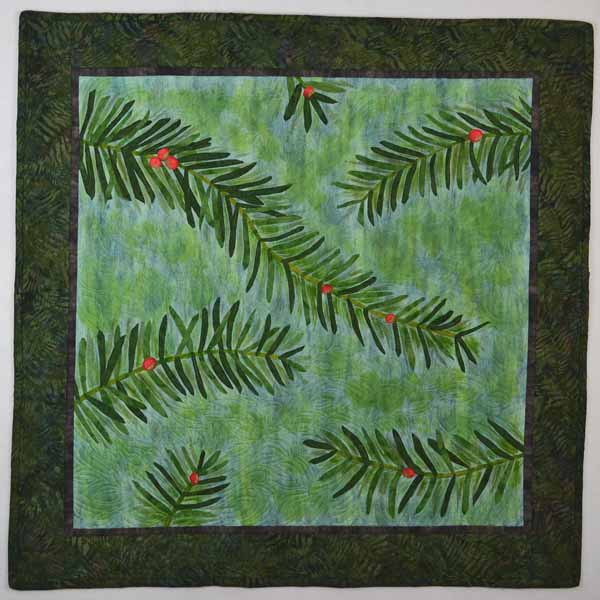 |
Vivian Milholen
Pacific Yew (Taxus brevifolia)
The bark, branches and needles of the Taxus brevifolia is the source of the successful anti cancer drug now known as Taxol. Taxol is used in the treatment of breast, ovarian and other types of cancers.
Survivor Tribute: Della Milholen (Mother-in-Law), Skin Cancer, 2001 |
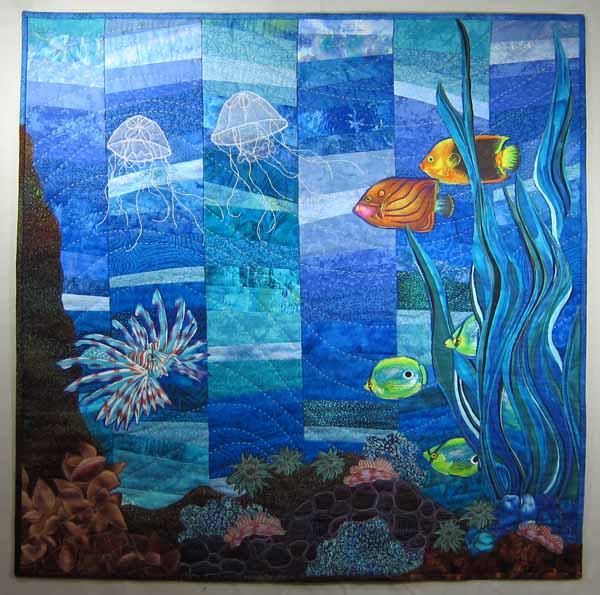 |
Carole A. Nicholas
Paradise Cove I
Kahalalide-F is anti-tumor agent isolated from the marine sea slug Elysia rufescens, which looks like a garden slug in desert camouflage, with twin ruffles down its back. This drug has been in clinical trials in Europe.
Survivor Tribute: David Nicholas, Prostate Cancer, May 2007
|
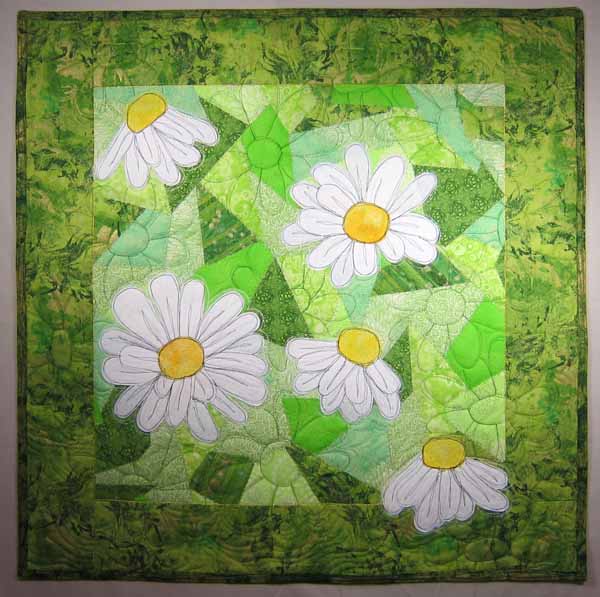 |
Lisa Ellis
Feverfew (Tanacetum parthenium)
Feverfew is a member of the Chrysanthemum family, sometimes called bachelor's buttons. Scientists have found that an extract of feverfew is effective against a type of human leukemia. The active ingredient is derived from parthenolide, one of a class of sesquiterpene lactones found in the plant.
Survivor Tribute: Francesca Adler-Baeder, Breast Cancer, 2009 |
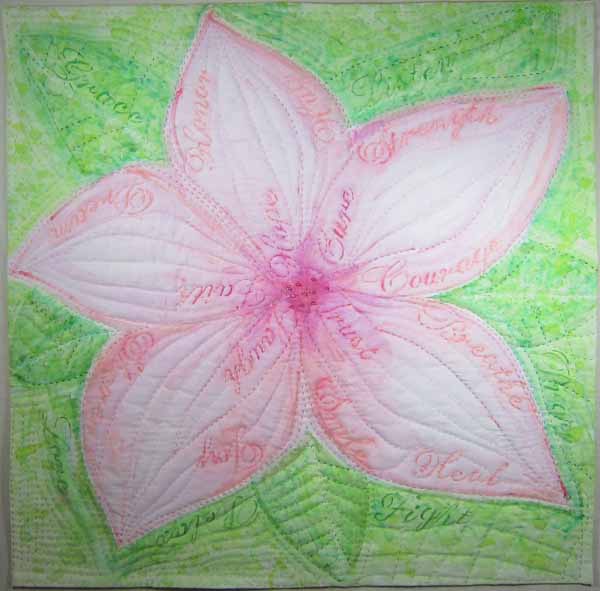 |
Sandi Goldman
Encouraging Words II
The Rosy periwinkle (Catharanthus roseus)also known as Vinca, is used to make two cancer drugs; Vincristine, to treat childhood leukemia and Vinblastine, to treat Hodgkin's disease. I hope these words of encouragement help someone through a tough day.
Survivor Tribute: Carolyn McDonald, Breast Cancer, 2011 |
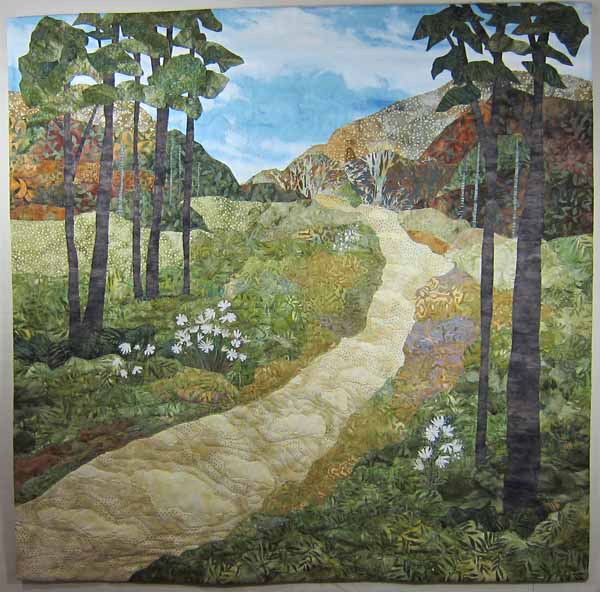 |
Vivian Milholen
Purple Meadow Rue (Thalictrum dasycarpum)
The seeds of Thalictrum dasycarpum contain the chemical thalicarpine, which is being studied as a potential anticancer drug to treat ovarian cancer cells, human malignancies and leukemia.
Survivor Tribute: Della Milholen (Mother-in-Law), Skin Cancer, 2001 |
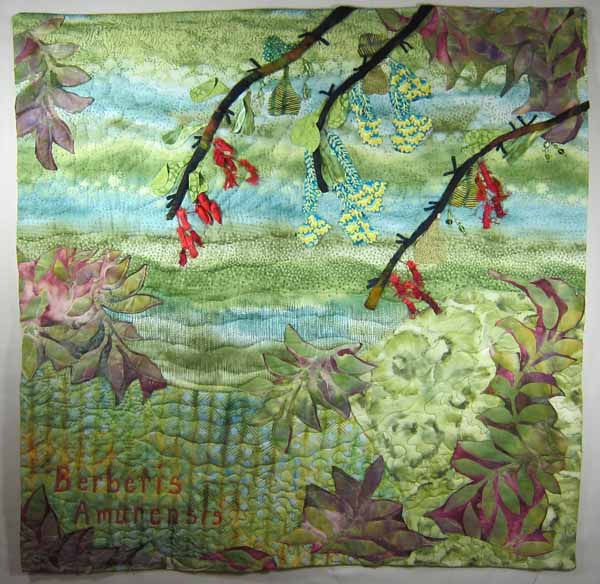 |
Annabel Ebersole
Berberis Amurensis (Xiaoboan)
This plant is in the bayberry family. It is the source of Berbamine, which is used to suppress the growth, migration and invasion of highly metastatic human breast cancer. It is also effective in treating leukemia and low blood count disease.
I created a leafy background for the branches of the Bayberry. The yellow blossoms progress to green immature berries and then to mature red berries. It was fun to bead the green berries and to create slightly different color and texture of red berries. The thorns are a sharp reminder when you touch Bayberry that this plant means business.
Survivor Tribute: Mary Ann Luc, Lymphoma 1993, and Melanoma 1994 |
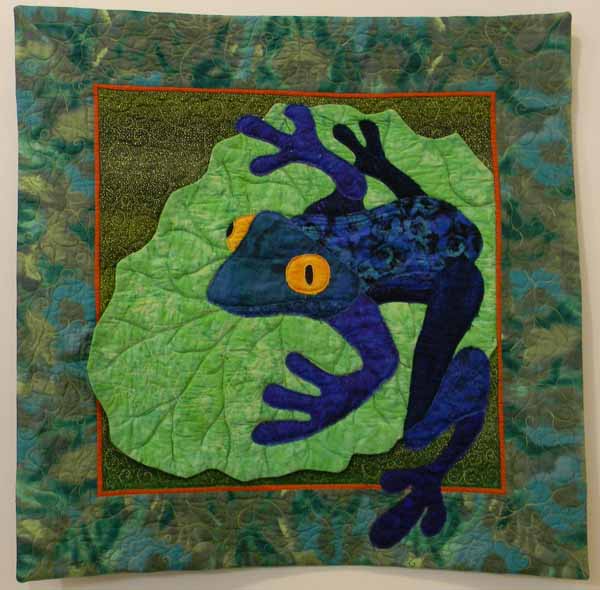 |
Barbara Hollinger
Poison Dart Frog III
The molecule, Tubocurarine, derived from the dart frog, Epipedobates, has shown to be an effective chemotherapy for certain types of brain cancer. Most varieties of these beautiful creatures are endangered.
Survivor tribute: Peg Jones, Breast Cancer, 2006 |
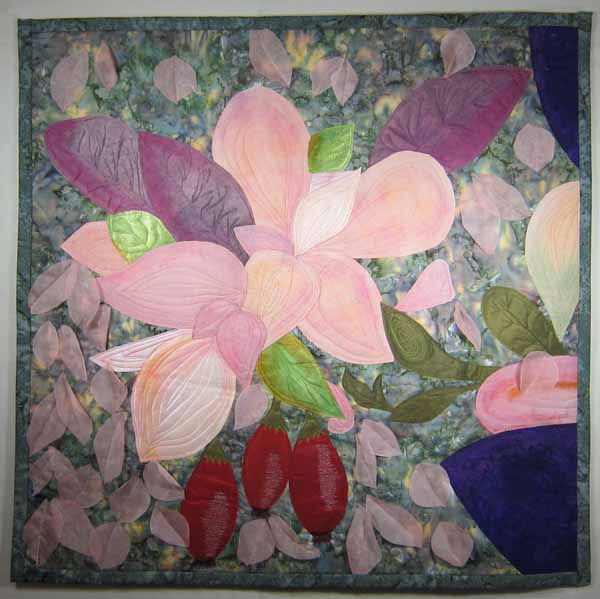 |
Christine L. Adams
How Does Your Garden Grow (Berberis amurensis)
Berberis amurensis is a tall broad deciduous shrub with clusters of creamy flowers ranging from salmon pink to peach. During the fall and winter clusters of orange/red berries emerge.
Berbamine, a derivative compound of this plant, is being developed to combat chronic myeloid leukemia.
Survivor Tribute: Jill Schumann, Breast Cancer, 1989 |
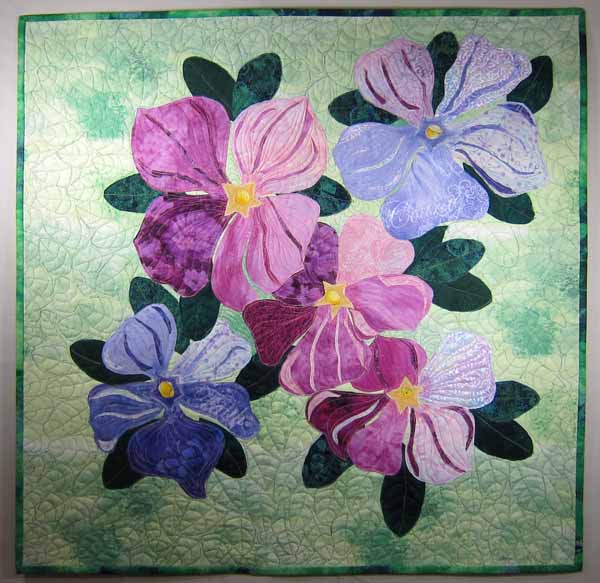 |
Bunnie Jordan
Five Periwinkles (Catharanthus roseus)
The rosy periwinkle is a flowering plant from Madagascar used by traditional healers there to treat diabetes. Western scientists discovered it's remarkable anti-cancer properties and have used the plant to develop two very important medicines. Vinblastine and Vincristine are used to treat childhood leukemia and Hodgkin's Lymphoma and have helped increase the chance of surviving childhood cancers. I hope it's encouraging to all that sources of treatment continue to be researched and developed.
Survivor Tribute: Brad Jordan, Stage IV Hodgkins Lymphoma, 1998 (age 16) |


